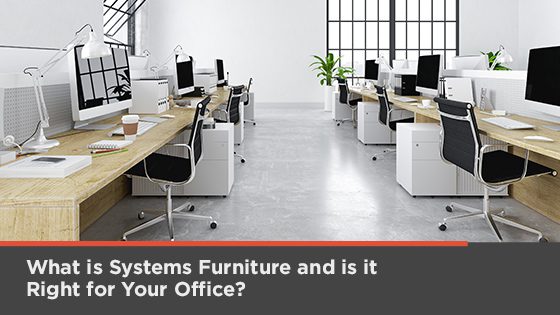Creating a custom modern office layout starts with choosing the right furniture. One of the most popular solutions in recent years has been systems furniture workstations.
A lot of companies looking for customizability and adaptability choose systems furniture for their office setup. If you’re looking for a flexible workplace furniture solution, then this might be the right choice.
However, before you pull the trigger, it’s essential to get a good understanding of what systems furniture can and cannot do to determine if the solution is right for you.
What Exactly is Systems Furniture?
Systems furniture is a modular furniture solution that provides the various parts needed to create workstations; conceptually, it’s like a Lego kit for office workstations. You may also hear of systems furniture referred to as modular furniture.
The modular style allows your office to be set up and adjusted according to your own unique needs. For companies that are experiencing rapid growth or want to create a flexible floorplan, systems furniture is a great solution that allows the office to adapt much more quickly to a changing work environment.
When you choose this type of furniture, you get all the components needed to piece together an office layout. These components can be moved, added or removed as you see fit; hence the name, systems furniture, or a comprehensive system of pieces that work together to create workstations.
The modularity of systems furniture allows you to create flexible solutions and adapt to your space quickly and efficiently without the downtime of significant renovations.
Why Choose Systems Furniture?
A lot of businesses may already have experience with some form of systems furniture. For example, a stereotypical cubicle is actually a form of systems furniture, albeit not a very modern one.
Systems furniture has evolved significantly over the past few years to encompass a wide range of furniture options, granting you the flexibility to design workstations that are as specialized, or as basic, as the users work style requires.
Systems furniture can be used to create a more collaborative workspace for employees. This style of workspace has become incredibly popular recently with companies like Google emphasizing collaboration instead of individual offices.
If you want your office to have a collaborative, co-working-style feel then moving away from stand-alone desks and toward grouped workstation configurations can be a great way to achieve this. The modularity of systems furniture gives your office layout a more agile feel. Adjust as teams or departments expand to suit the changing needs of your business.
Organizations that are rapidly growing and experiencing change may also see this model as a way to quickly adapt to their needs. Instead of ordering new desks for new employees, companies can order only the parts they need, reusing existing modular components to add to their existing configuration.
Modular systems furniture saves on space when compared with bulky, individual desks. You can fit more people into a smaller space without having to spend money moving to a more spacious office. These more efficient layouts also allow you to use panels, power and data runs and storage for more than one workstation, reducing the total number of components that need to be purchased.
Impending renovations or location changes are also great reasons to consider systems furniture. If you are unsure of how your workspace may look in the future, then you may want to opt for the flexibility this setup can offer to ensure that you can make the most of the new space without having to incur major expenses on new furniture.
What Can’t Systems Furniture Do?
While systems furniture offers a lot of flexibility, it may not be the right solution for every business. There are some considerations to keep in mind before opting for them.
- First, this type of furniture is designed for maximizing space with smaller footprints. If you need to have full auditory privacy for the users (for example, human resources teams), then systems furniture may not meet your unique needs.
- A lot of people also see that systems furniture is modular and think this kind of furniture can be moved. While it is very flexible and agile, it simply isn’t reasonable to take it apart for a meeting and then move it back once the meeting is done. If you are looking for furniture that agile, you may want to look at other furniture solutions such as using tables rather than full workstations.
- Finally, furniture alone cannot change your workplace culture. Creating an open, collaborative culture takes more than a sleek new workstation layout. Look for ways to foster a more collaborative environment, use software solutions to help increase productivity, and ask your employees how you can reduce red tape to achieve the workplace mentality you want. Furniture is only one piece of the puzzle. This Haworth whitepaper digs a little deeper into changing workplace culture if you are interested in reading further.
For a more in-depth breakdown of the drawbacks of using systems furniture workstations and what you can do to offset them, click HERE.
Learn More About Systems Furniture
Are you thinking systems furniture might be the right solution for you but not quite ready to take the plunge? Is it because you aren’t sure just how much this is going to cost you? We’ve got you covered! We wrote an article breaking down how much you should budget for systems furniture workstations and what factors can impact their price!
Our mission is to help you create a more productive office environment; if you do opt for systems furniture, we can provide you with suggestions and advice to make the most of your new workspace.
Bought into the idea of systems furniture, but not yet decided who to get it from? In our Guide to Purchasing Office Furniture, we break down how to find the office furniture dealer who best aligns with your needs and much more!
Cory Porteous
Marketing Manager
Office Interiors




